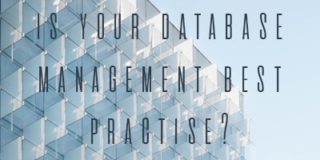Is Your Database Management Really Best Practice?
If you’re running a tour business, then chances are you have to store quite a lot of information on your computer systems. Every tour operator is juggling supplier rates, booking dates, client information, flight details, special meal requests and so much more.
 It’s all important information, there is so much of it and you need to ensure that it’s logged in a system that keeps it secure, accurate and most importantly accessible for easy use. After all, you’ll be heading for a world of trouble if the wrong check-in dates are logged for a client itinerary or even worse the file is producing a lower than budgeted yield.
It’s all important information, there is so much of it and you need to ensure that it’s logged in a system that keeps it secure, accurate and most importantly accessible for easy use. After all, you’ll be heading for a world of trouble if the wrong check-in dates are logged for a client itinerary or even worse the file is producing a lower than budgeted yield.
So how can you improve your database setup? Start off by assessing your current database, and then taking a look at a modern software solution.
Allow me to explain.
Assessing Your Database
If you’re using an outmoded form of database management like a spreadsheet program, the chance of an error occurring is going to be quite high. After all, many of these ways of managing a database were never actually designed for this task. Spreadsheet software is incapable of automatically advising suppliers of the needs of your clients, for example, and cannot create quotes accurately or even quickly. Even worse individual spreadsheets aren’t linked resulting much manual processing.
The use of Microsoft Word and Excel relies on the manual process of cut and paste to move a file from the first quote to final accounting. This is highly repetitive and absorbs thousands of hours of administration time every year. You probably already know this but do you know how much time it is costing you?
There can also be problems when the spreadsheet software changes versions, and it could throw your database into disarray. This isn’t the fault of the software, it’s just not fit for purpose. So what is? Let’s take a look at what a better, more modern alternative can do for your operations.
Using Tourwriter
Updating to a new and more powerful piece of software is the best way to more effectively manage your database, and it’s the only way you can take advantage of the efficiency a single database offers with all information easily shared amongst staff and allowing you to integrate with modern systems.
These include compatibility with third-party accounting interfaces, easier ways to update supplier details and manage client information with CRM for sales automation.
What’s more, it’s also adept at reducing the chance of simple errors, which in turn means your staff gets to spend less time hunting out their mistakes and more time selling.
As I’ve said before, it’s important to use the right solutions to get your databases in order. These systems are responsible for a lot of important information, and it’s crucial that this data is kept both secure and easily accessible. Of course, you also want a system that helps to reduce the chance of simple errors!
A more effective database isn’t difficult to put in place, especially once you know exactly where you want to improve.




